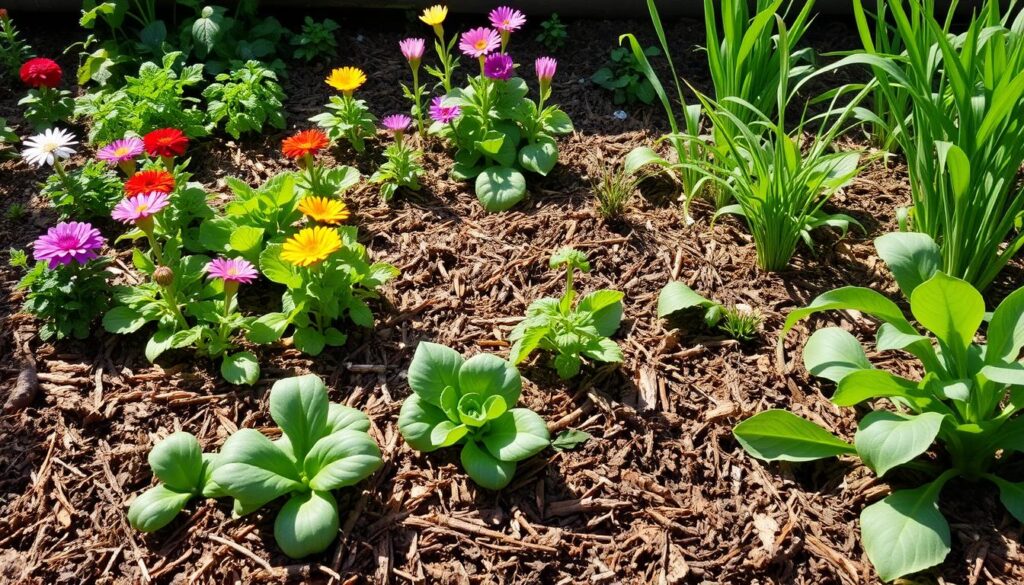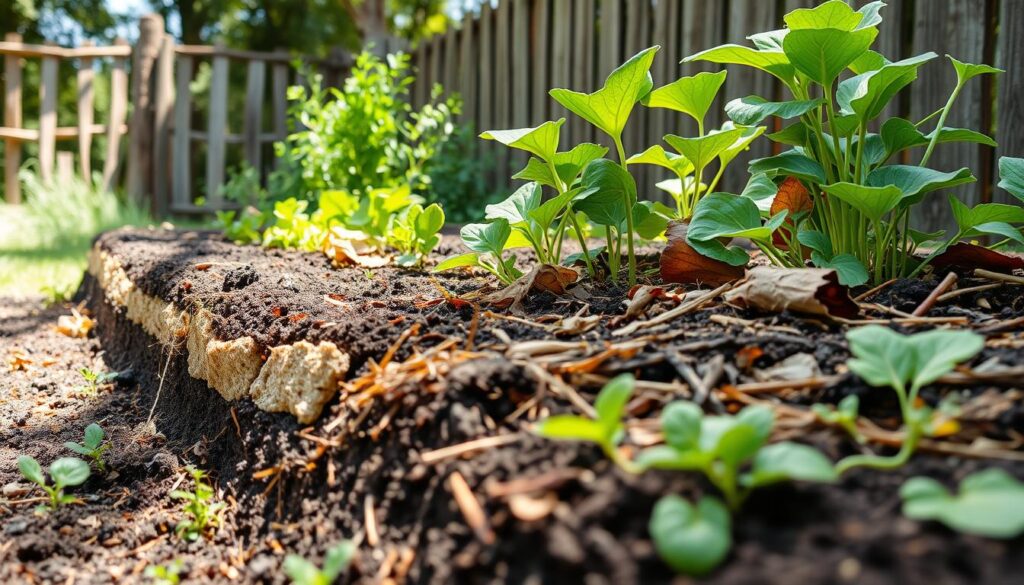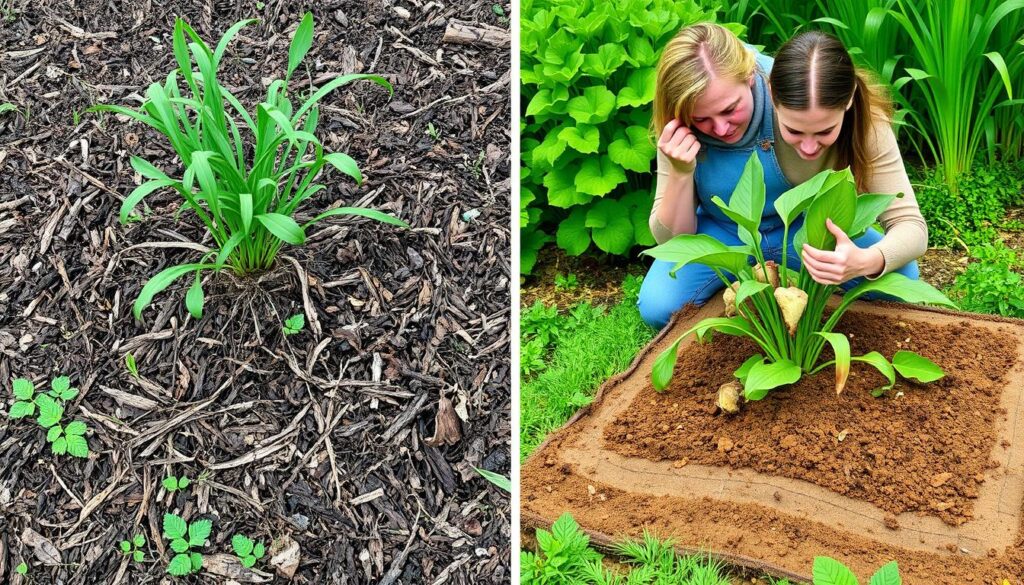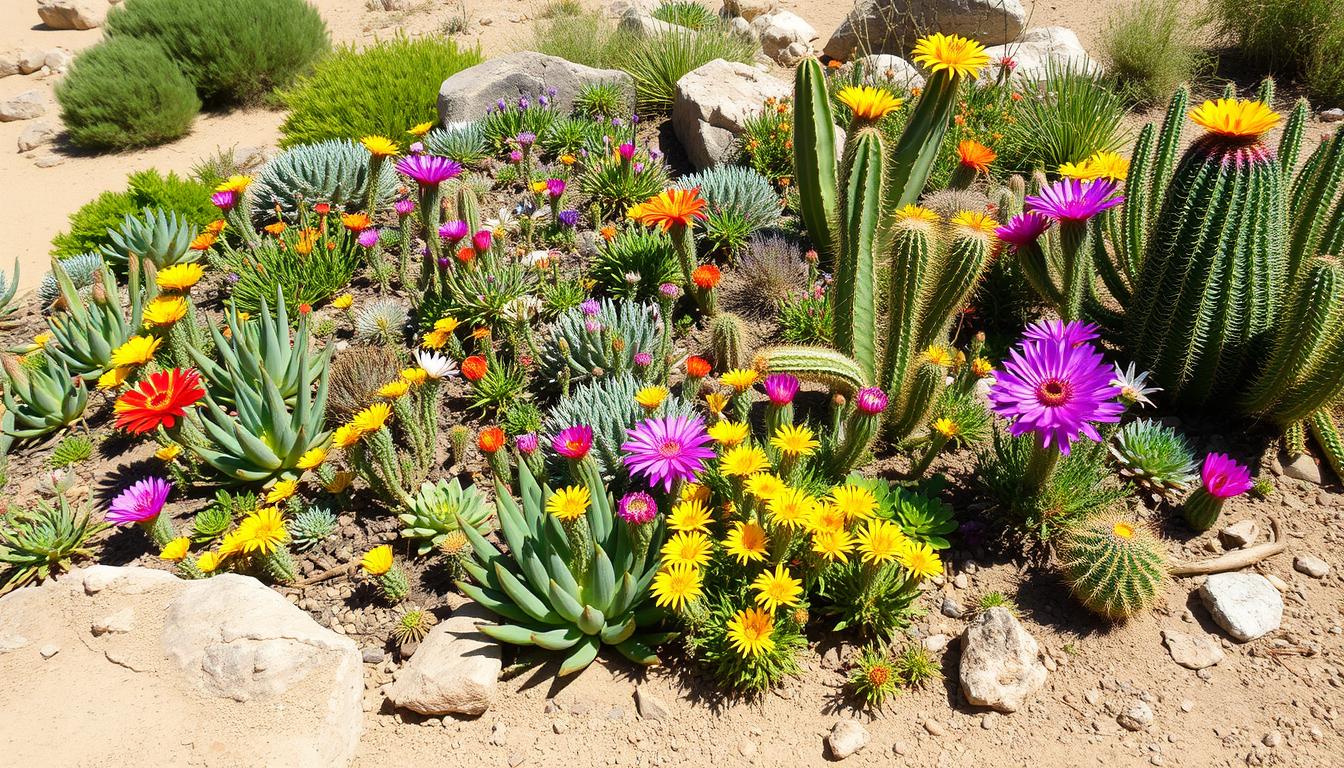Imagine a bustling urban neighborhood where every shared garden plot thrives. Yet, the gardeners are rarely seen toiling in the dirt. As autumn leaves fall, a local gardening club meets weekly. They share tips on no-dig gardening, a method that makes gardening easier and more rewarding.
By not disturbing the soil, they grow vibrant plants with less effort. Stories of thriving gardens and less backache spread. It’s clear this method is transforming gardening for them. They leave inspired, ready to enjoy their gardens without the old labor.

Key Takeaways
- No-dig gardening promotes a healthier ecosystem and soil structure.
- Reduced physical labor leads to greater enjoyment of gardening.
- Techniques of no-dig gardening can improve plant yields.
- Less effort in maintenance translates to more leisure time in the garden.
- Soil health is key for successful planting and growth.
Understanding No-Dig Gardening
No-dig gardening is a new way to grow plants that doesn’t harm the soil. It lets plants grow better by keeping the soil healthy. To really get it, you need to know its basics and where it comes from.
What is No-Dig Gardening?
No-dig gardening means adding compost and mulch on top of the soil. This keeps the soil’s natural structure intact. It helps earthworms and other soil life thrive. This way, plants grow strong and healthy.
History and Origins of No-Dig Gardening
Gardening has always been about finding better ways to grow food. No-dig gardening comes from permaculture, which aims to mimic nature. Many cultures have used these methods for a long time.
People like Ruth Stout and Geoff Lawton have made no-dig gardening popular. They shared their knowledge through books and workshops. Their work shows how important healthy soil is for gardening success.
Benefits of No-Dig Gardening
No-dig gardening offers many advantages that can make gardening better and more rewarding. These benefits can encourage anyone to try this eco-friendly approach.
Reduced Labor and Effort
No-dig gardening cuts down on hard work and effort. Old-school gardening needs a lot of tilling, which is tough and takes a lot of time. No-dig makes gardening easier and more fun for everyone.
Improved Soil Health
No-dig gardening is great for soil health. It keeps the soil’s natural structure, which is good for beneficial bugs and worms. This leads to better nutrient retention and less soil loss. Healthy soil means plants grow well.
Increased Plant Growth
Good soil health means plants grow better. Plants do well in soil full of nutrients and organic matter, which no-dig gardening provides. This creates a perfect spot for a big harvest of tasty, healthy food.
| Benefits | No-Dig Gardening | Traditional Gardening |
|---|---|---|
| Labor Intensity | Low | High |
| Soil Erosion | Minimal | Significant |
| Nutrient Retention | High | Variable |
| Plant Growth | Robust | Dependent on Soil Condition |
The Magic of No-Dig Gardening: Less Effort, Better Growth
No-dig gardening uses smart methods to improve soil and make garden care easier. It uses organic materials to create a healthy environment for plants. This approach makes gardening simpler and more rewarding.
Effective Natural Soil Improvement Techniques
No-dig gardening focuses on adding layers of organic matter. This can include:
- Straw
- Grass clippings
- Leaves
- Compost
These materials make the soil rich in nutrients. They help plants grow well by improving soil structure and supporting beneficial microbes.
Anti-Weeding Methods and Maintenance
No-dig gardening helps control weeds. The layered system keeps weeds down, making garden care less stressful. Gardeners can focus on important tasks without feeling overwhelmed.
- Using organic mulch to retain moisture
- Reducing the frequency of watering
- Offering ongoing weed control
This approach makes garden maintenance easy and fun. It keeps gardening enjoyable and productive.
No-Dig Gardening Techniques
No-dig gardening offers many ways to make your garden sustainable and healthy. Three key techniques are layering, natural mulching, and composting. Each method helps your garden grow well.
Layering for Success
Layering means stacking organic materials to improve soil. This creates a rich environment for plants and beneficial microbes. By using materials like grass clippings and straw, you help plants grow strong and the soil gets better.
Natural Mulching Practices
Natural mulching keeps the soil in good shape. It uses materials like wood chips to prevent erosion and keep moisture in. Mulch also stops weeds and makes the soil better as it breaks down.
Composting as a Foundation
Composting is key in no-dig gardening. It turns kitchen waste and yard clippings into plant food. This method makes the soil richer and helps plants grow well.

| Technique | Benefits | Materials Used |
|---|---|---|
| Layering | Enhances soil fertility and microbial activity | Grass clippings, leaves, straw |
| Natural Mulching | Protects soil, retains moisture, suppresses weeds | Wood chips, dried leaves, straw |
| Composting | Provides nutrients, reduces waste, enriches soil | Kitchen scraps, yard waste, organic matter |
Sustainable Gardening Practices with No-Dig Methods
No-dig gardening fits well with sustainable gardening. It encourages an eco-friendly way to grow plants. This method lets gardeners care for their plants naturally, without harmful chemicals.
Organic Gardening Integration
Adding organic gardening to no-dig gardening boosts soil and plant health. Using compost and natural fertilizers makes the soil rich in nutrients. This not only increases yields but also makes the garden healthier and more diverse.
Eco-Friendly Gardening Techniques
Using eco-friendly methods like companion planting helps plants grow better and keeps pests away. Crop rotation keeps the soil fertile and stops pests from coming back. These practices make the garden sustainable and environmentally friendly.
Common Challenges in No-Dig Gardening
No-dig gardening has many benefits, but it also comes with challenges. Weed control is a big issue, as some weeds are hard to get rid of. Finding ways to control weeds without harming the soil is key to success.
Weed Control Strategies
It’s important to have good weed control in no-dig gardens. Here are some ways to keep weeds away:
- Layering mulch effectively to smother weed growth.
- Utilizing landscape fabric to provide a barrier against weeds.
- Applying organic weed suppressants like vinegar or salt.
Natural Pest Management Solutions
Keeping pests away naturally is important for a healthy garden. Using natural methods helps avoid harmful chemicals. Here are some ideas:
- Introducing beneficial insects such as ladybugs and lacewings.
- Creating homemade insecticidal soap from natural ingredients.
- Encouraging biodiversity to attract predatory species that control pest populations.

Overcoming these challenges makes gardening better and more rewarding. With the right weed control and natural pest management, gardens can flourish.
Successful No-Dig Gardening: Tips and Tricks
To have a successful no-dig garden, you need to plan well. Choosing the right plants is key. Also, placing them correctly helps them grow well. Using garden tips can make your outdoor space flourish.
Selecting the Right Plants
Choosing the right plants is the base of no-dig gardening. Pick plants that love rich, layered soil. Native plants are great because they need less water and care.
Combining perennials with annuals makes your garden lively. This mix ensures your garden stays beautiful all year.
Optimal Placement and Planning
Knowing your garden’s microclimates is important. Look at how sunlight, wind, and water affect each area. This helps you place plants where they’ll do best.
Make sure to space plants well. This stops them from fighting for food and water. It lets each plant grow as much as it can.
Conclusion
No-dig gardening is all about simplicity. It uses effective methods that make gardening easier and promote healthy plants. This way, gardeners can enjoy a thriving garden with less hard work.
Key steps in no-dig gardening include improving soil naturally and choosing the right plants. A well-thought-out garden layout is also vital. These steps help both new and seasoned gardeners create a beautiful, easy-to-care-for garden.
No-dig gardening changes how we see our gardens. It highlights the need for sustainability and caring for the environment. By using this method, gardeners not only improve their own gardens but also help the planet. They create gardens that are not only beautiful but also strong and resilient.
FAQ
What are the main benefits of no-dig gardening?
No-dig gardening saves you a lot of work. It makes the soil healthier and helps plants grow better. This method keeps the soil’s natural balance, keeping nutrients and moisture in place.
How does no-dig gardening improve soil health?
It keeps the soil in good shape and supports good bugs and worms. Adding compost and mulch makes the soil rich and full of life. This is key for plants to grow well.
What techniques can I use for successful no-dig gardening?
To do well in no-dig gardening, layer organic stuff, use natural mulch, and compost. These steps help the soil and plants grow strong, with less work needed.
How can I control weeds in a no-dig garden?
To fight weeds, use good mulching, organic weed killers, and landscape fabric. Organic layers help keep weeds down while keeping the soil healthy.
Is no-dig gardening compatible with organic gardening practices?
Yes, no-dig gardening fits well with organic gardening. It uses natural ways to improve the soil, avoiding harmful chemicals. This creates a good place for plants to grow.
What are some easy gardening methods in no-dig gardening?
Easy methods include adding organic layers for fertilizer, using mulch for water and weed control, and composting. These steps make gardening simpler and help plants grow well.
Can no-dig gardening help with pest control?
Yes, it can help control pests naturally. By using beneficial bugs, native plants, and organic pest solutions, you can keep pests away without harming the environment.
How do I select the right plants for a no-dig garden?
Choose plants that like rich, layered soil and fit your area. Native plants often need less care and help the local ecosystem.
What are the key challenges in no-dig gardening?
Main challenges are weeds and pests. Use good weed control and natural pest solutions to overcome these. This keeps your garden healthy and thriving.




